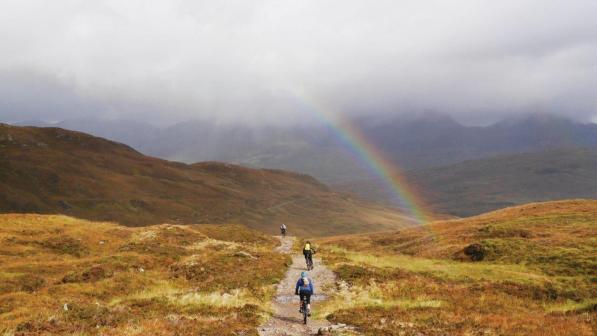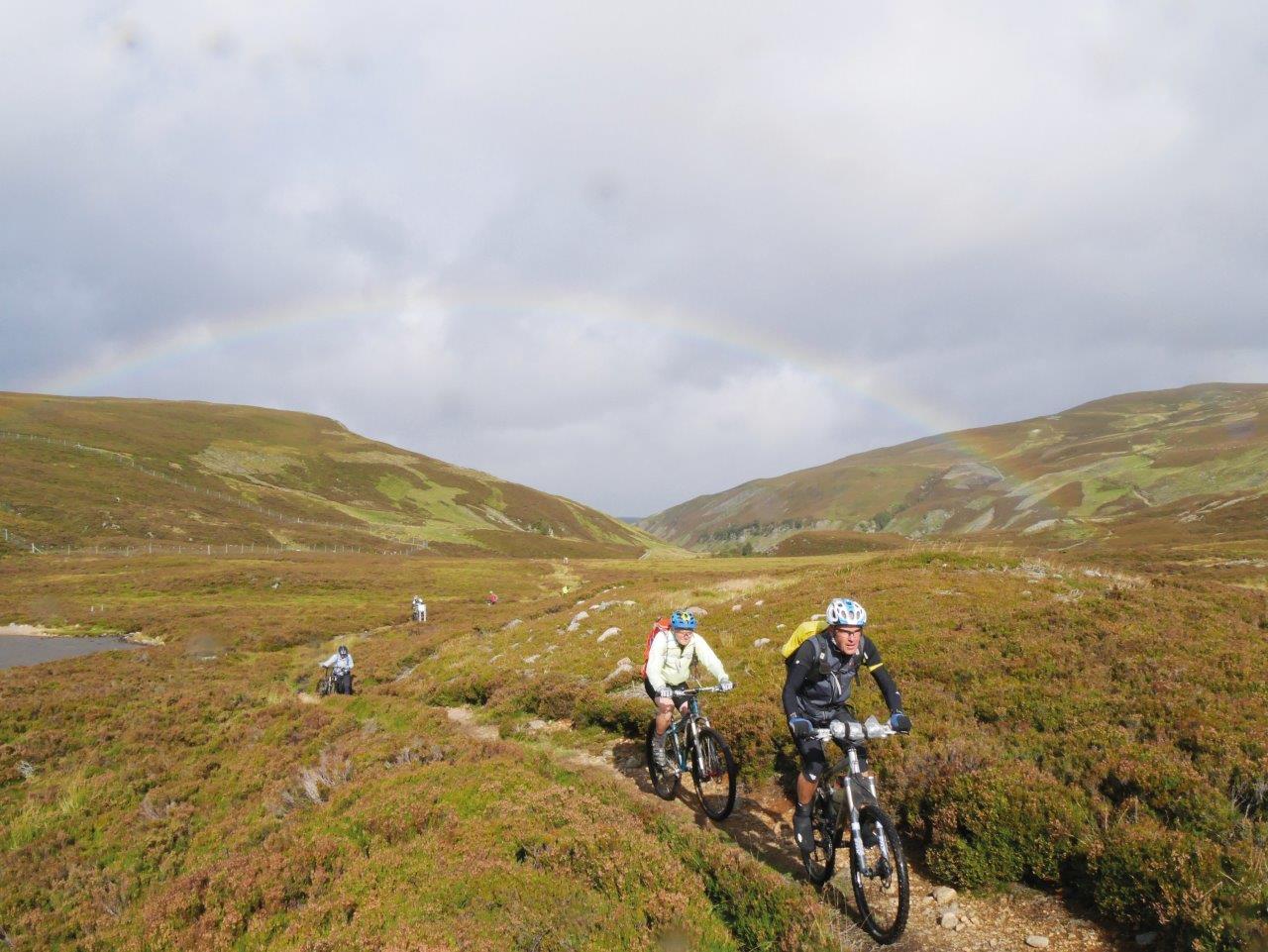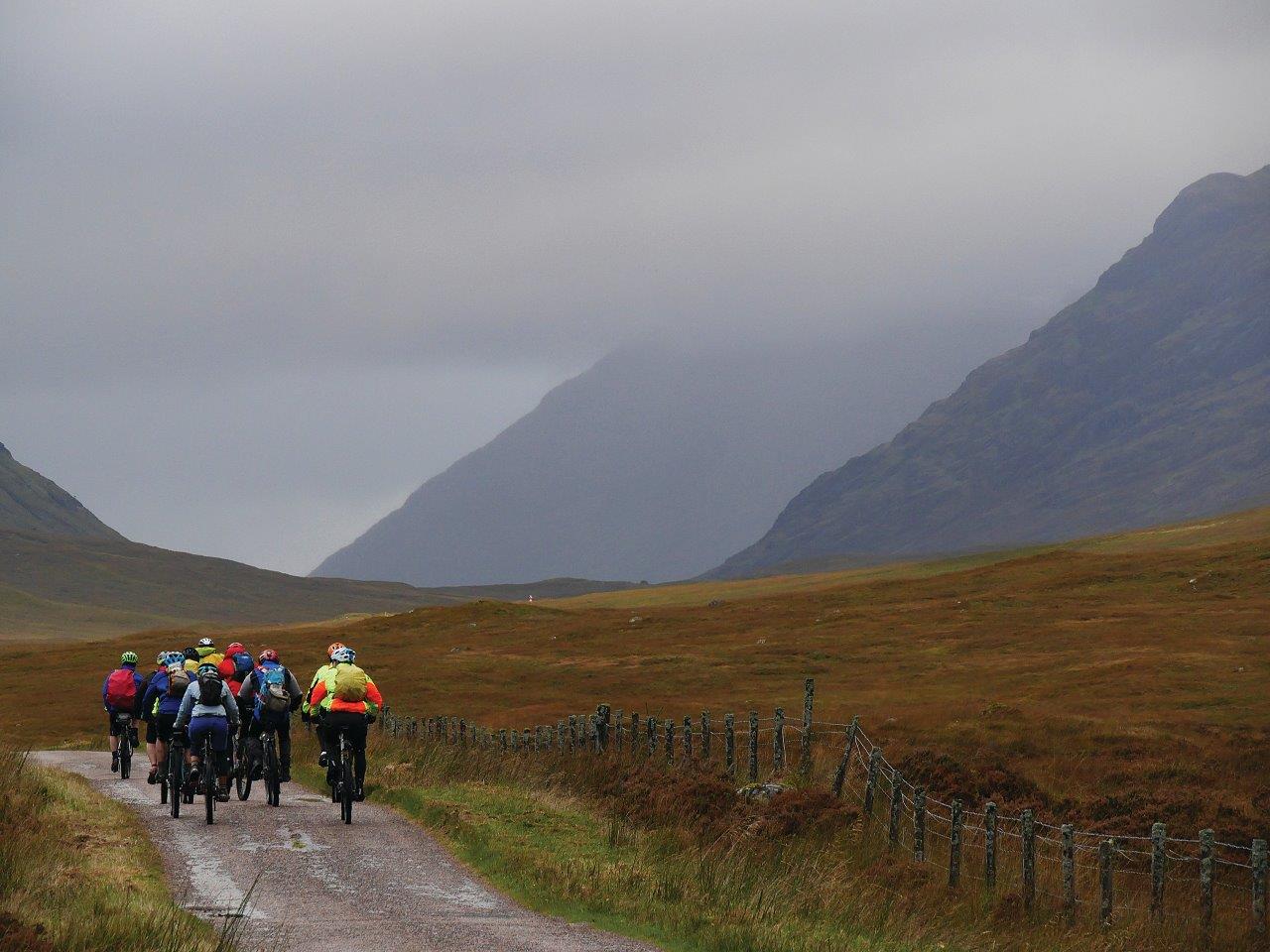Great Rides: West Highland Way

The West Highland Way needs little introduction for lovers of the Scottish outdoors. Its 93 miles (89 in our version) weave past a hit parade of Scottish scenery, including Loch Lomond, Rannoch Moor, Glencoe, and Glen Nevis. Traditionally used by walkers, the increasing popularity of off-road touring, and the availability of capable full-suspension and fat bikes at reasonable cost, opens this sort of trip to cyclists. And because it’s possible to complete the journey in less time by bike, it makes sense to continue onwards – in our case, completing a west-to-east coast-to-coast through the heart of the Cairngorms to Montrose.
It was a motley crew that gathered at the Premier Inn in Milngavie, ten miles north of Glasgow, where the route begins. (The pronunciation of ‘Milngavie’ – the ‘n’ and the ‘v’ are silent – immediately betrayed the southerners, though the ticket assistant at Glasgow station did his best not to laugh.)
Most of us had ridden together on Paul Rogers’ Sarn Helen tour, off-road from the top to the bottom of Wales, two years previously, a trip that already seemed to us impressively epic.
Like the reunion of Butch Cassidy’s gang, we were now back together for Paul Rogers’ next mission. Paul Whitaker, now 75, had been the senior rider in Sarn Helen. Now sporting a grizzly grey beard, he was even more like the Ancient Mariner on a land adventure. Impeccably sure-footed downhill, he was steady but unstoppable up the other side. His veteran Santa Cruz seemed unbreakable. And despite all of this, he was always the last to leave the pub the night before.
What bike for…
We had three policemen on the team, so we never had any trouble staying on the straight and narrow in the hills. One of our officers, Phil Nelson, had disappointed us all by retiring the vintage Marin he’d been riding for nearly 20 years. With its rubber suspension and V-brakes, no one had expected it to last the Welsh tour. It had now had enough of being laughed at and was enjoying a much-deserved retirement in the shed. Unfortunately, Phil himself, after riding expertly on his new bike for four days, picked up a chest infection and had to join the support vehicle for the second half of the trip.
The mass purchase of full-suspension bikes was the most noticeable change since our Welsh tour.
Matthew Wright
Adrian, from Cardiff, was acknowledged as our fastest, most technically capable rider. Honed by the warren of singletrack in the hills above Cardiff, when the trail turned sharply downhill he would leave us in the dust. I was thrilled to discover that having recently graduated to a 160mm, full-suspension Cotic Rocket (from a 26in steel tourer with a short front suspension fork), I could now nearly keep up with Adrian. Together, we were definitely the best at getting punctures, using too-soft tyres for the many razor-edged granite drainage channels on the local trails.
In fact, the mass purchase of full-sus’ bikes was the most noticeable change since our Welsh tour. This time, everyone bar the ultra-tough local boy, Keith Adams, had a cushioned back end. Most days included some technical (in a few cases precipitous) sections when that capacity to drop off or roll over obstacles was very useful. Even apparently simple paths usually had steps, ditches or other cycling challenges. It was, after all, originally designed for walkers.
Trail etiquette
The Way both starts and ends on shopping streets, with little indication of the adventure ahead. So we set off pushing our bikes through Milngavie’s pedestrianised precinct, looking a bit over-prepared for a trip to Tesco. The route attracts about 80,000 visitors a year, and we didn’t get a second glance from the local shoppers. Then, within a few miles of the supermarkets, we had escaped into the rugged valley between the Kilpatrick and Strathblane Hills.
We soon had a rude awakening about the demands of the tour with the ascent of Conic Hill, which rears up brutally near the south-eastern shore of Loch Lomond. Though the ascent itself is cyclable by the super-fit, there are numerous stone drainage channels to be hopped over, and the top half is freakishly difficult. For serious mountain bikers, much of the descent is also rideable, though it was one of three or four steep, technical descents that demanded fine balance and bike control. A couple of them, Conic Hill and the Devil’s Staircase, offered a sheer drop if you got it wrong.

The other consideration, at this point, was the fact that the West Highland Way – though enjoying shared access – is still primarily a walking route. Conic Hill is a popular section, and walkers were unsurprisingly alarmed to see platoons of mountain bikers plummeting towards them. On busy sections of trail, it tended to be better all round to walk the steepest bits. This needs to be remembered by anyone planning to ride the West Highland Way, although, with the most basic sense of consideration, shared-use worked perfectly.
Punctures and precipitation
As the trail steepened at the foot of Conic Hill, we had our first puncture. Or rather, I did, trusting my new rear suspension a little too exuberantly to cope with the stone drainage slabs. That night, Paul Rogers handed round a pressure gauge and a stern look. Once pressures were safely into the 30s, most of us stopped puncturing, except for Adrian. After all, he could fix a flat and catch us up by the next summit. After Conic Hill, we had a picnic, provided almost every day by lunch angel, radio operator and support driver Maxine. Three or four members of our crack team had to sit out half a day or more in her van with various ailments, and for a group this size, motorised backup was essential.
The West Highland Way is primarily a walking route but with considerate riding, shared-use works perfectly.
Matthew Wright
Once we reached Rowardennan, halfway up the east bank of Loch Lomond, we took the ferry across to Tarbet on the west coast, even though the West Highland Way continues up the east bank. This is an essential detour for cyclists, even though it means missing some scenic (but completely unrideable) forest track in the shadow of Ben Lomond and replacing it with a tedious slog up the A82, especially unpleasant in the by now heavy rain, which continued, on and off, for 24 hours.
Next day, we set off in a persistent, driving wetness that saturated usually breathable fabrics and filled up waterproof socks so they bulged like water balloons. The cloud obscured the Grampians as we shadowed the main road to Bridge of Orchy. But the afternoon briefly cleared, so that as we skirted the Black Mount the vast wilderness of Rannoch Moor opened up to the east as, for me, one of the views of the trip. The track around the moor was fast, jumpy and exhilarating. As we fixed another of Adrian’s snakebite punctures at the top of the final descent to the Kings House at Glencoe, the wind picked up and the rain began again, stinging like grapeshot. At moments like this, the joy and wonder of being outside in a wild environment becomes overwhelming.

Wild Scotland
The last 30 miles of the West Highland Way are joyful riding. The Devil’s Staircase is a steep walk up, and a wonderful (though technical) blast down. A steep climb out of Kinlochleven is repaid with a glorious, technical fast track around Mamore Forest and a swooping trail through Nevis Forest, eventually leading down into Fort William.
Both ends of our coast-to-coast required a flat ride to where the off-road fun starts, in Fort Augustus (a beautiful town, home to the Nessie industry) and Edzell respectively. The ride along the Caledonian Canal from Fort William can be done by trail in the Leanachan Forest, though there’s a Sustrans route following the water that’s both attractive and a little more restful for tired legs. We didn’t have time for a rest day, but Fort Augustus and a boat trip to visit Nessie would probably be the place to have it.
The climb out of Fort Augustus to the Corrieyairack Pass was one of the most beautiful sections of a ride that has much competition for the best view. The sun shone, Loch Ness sparkled and the heather buzzed with late-season bees. The pass itself was probably the remotest part of our tour. For perhaps three hours we enjoyed vast, silent, empty space, something that’s very rare in Britain. Though the track is accessible by jeep, the ride is quite straightforward technically (though steep). Back down in the valley, we rode past Laggan Wolftrax trail centre. A few of us had a spin round, as if the thrills in the hills were not already enough.
Stunning shortbread-tin scenery
The next three days were so impossibly beautiful that looking back at the photos feels completely unreal. Crags, valleys, streams and peaks blended with a breathtaking harmony, and the mixed weather often meant a rainbow smiled over us. Tomintoul to Braemar, through Glen Avon and the heart of the Cairngorms National Park, was marginally the most stunning off-road section.

The riding was great, too, when we could bring ourselves to look down from the views. Without anything like the volume of walkers of the West Highland Way, there are many miles of pristine singletrack. Much of it, through the glens, is not especially steep, but it twists and flows in a way that’s deeply satisfying.
Mt Keen was the toughest climb. As steep as the Devil’s Staircase, but slippery underfoot, the top half is impossible to ride. Near the top it evens out, with half a mile of twisty trail that skirts the summit, giving stupendous views down Glen Mark. Then the track plummets down a long, fast, lumpy track to the river. And that was the end of the adventurous riding. No broken bones, or bikes, and apart from Phil’s unfortunate (and unrelated) chest infection, the team had made it intact.
Edzell to Montrose we covered by road. The landscape along the east coast becomes curiously flat after so much jagged mountainscape, more like Suffolk than the Scotland we’d just experienced. But after so many days of riding, in which the extravagant and extraordinary scenery was burned into our memories, we each had our own virtual highlights reel to screen before our eyes, and relive for ourselves what must be one of the UK’s greatest off-road rides.




